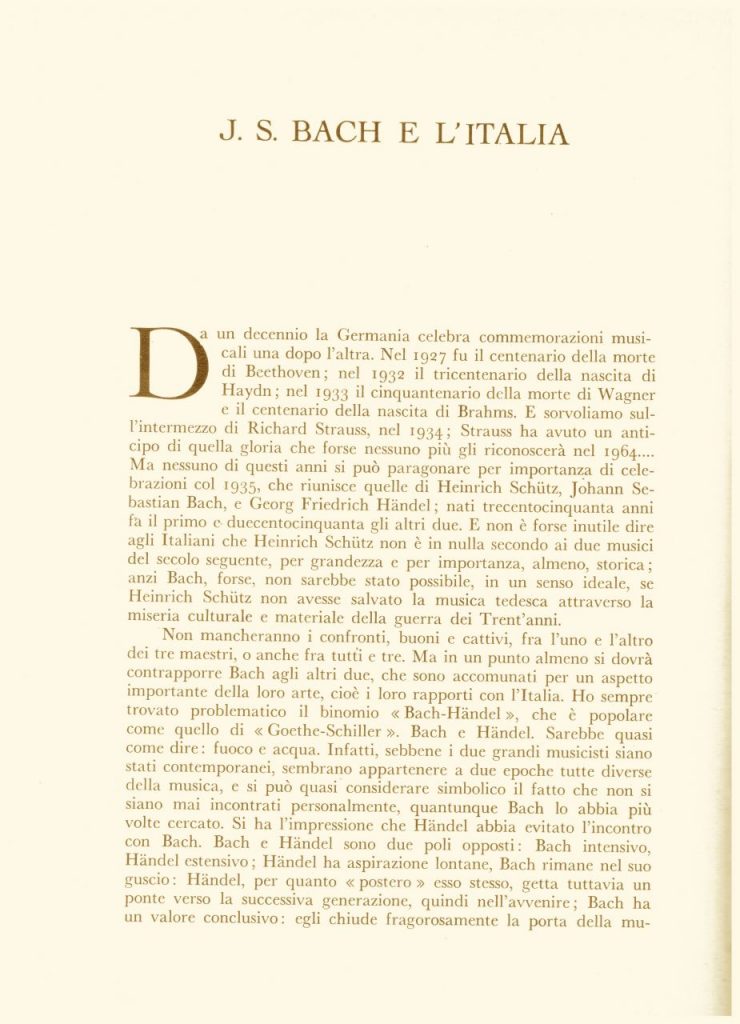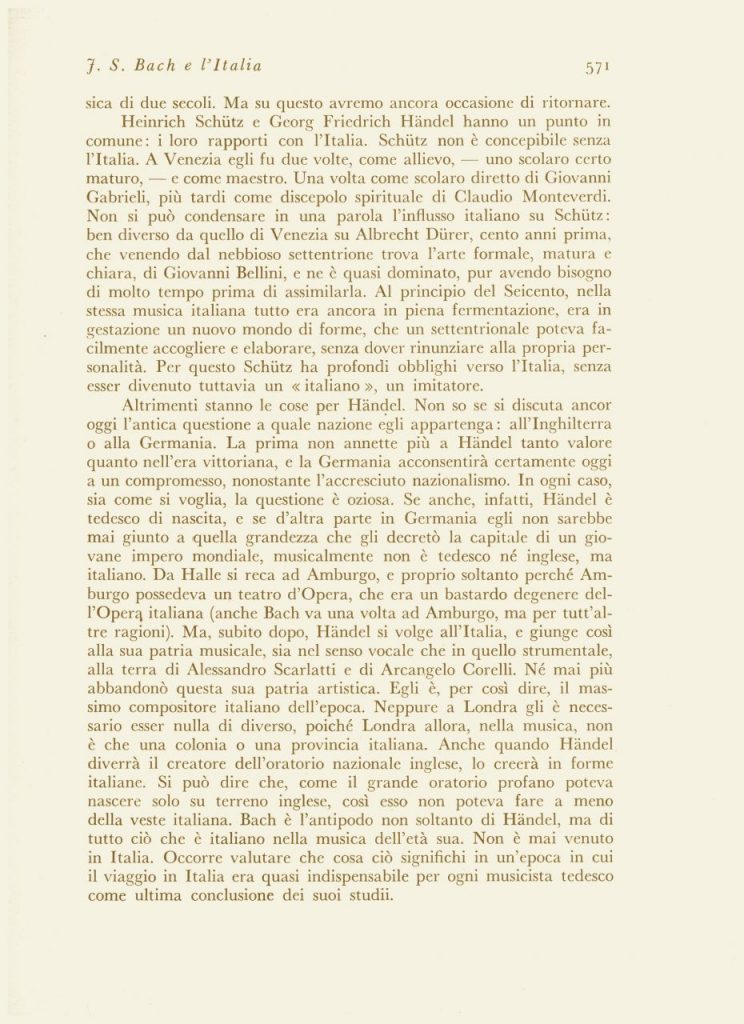JOHANN SEBASTIAN BACH e L’ITALIA-Articolo di Alfred Einstein-Rivista PAN n° di Aprile 1935-Biblioteca DEA SABINA
Biblioteca DEA SABINA
JOHANN SEBASTIAN BACH e L’ITALIA –
Articolo di Alfred Einstein per la Rivista PAN n°4 Aprile 1935
Biografia-Alfred Einstein, cugino del celeberrimo fisico Albert, iniziò la sua carriera come critico musicale del Berliner Tageblatt nel 1927. Si trasferì prima a Londra, nel 1933, poi in Italia dal 1935 al 1938, e in ultimo negli Stati Uniti a partire dal 1939. Negli USA insegnò presso lo Smith College di Northampton nel Massachusetts, alla Columbia University di New York, ad Ann Arbor, a Princeton e infine alla Julius Harrt School of Music di Hartford in Connecticut. Si ritirò dall’insegnamento nel 1950 per motivi di salute, dopo aver preso la cittadinanza statunitense nel 1945. Fu molto conosciuto all’epoca anche per l’approccio, dai toni spesso forti, tenuto nella sua attività di critico musicale.







Biblioteca DEA SABINA- JOHANN SEBASTIAN BACH e L’ITALIA -Rivista PAN n°4 Aprile 1935
Alfred Einstein (Monaco di Baviera, 30 dicembre 1880 – El Cerrito, 13 febbraio 1952) è stato un musicologo, critico musicale e accademico tedesco naturalizzato statunitense


Alfred Einstein (Monaco di Baviera, 30 dicembre 1880 – El Cerrito, 13 febbraio 1952)
Biography
Einstein was born in Munich. Though he originally studied law, he quickly realized his principal love was music, and he acquired a doctorate at Munich University, focusing on instrumental music of the late Renaissance and early Baroque eras, in particular music for the viola da gamba. In 1918 he became the first editor of the Zeitschrift für Musikwissenschaft; slightly later he became music critic for the Münchner Post; and in 1927 became music critic for the Berliner Tageblatt. In this period he was also a friend of the composer Heinrich Kaspar Schmid in Munich and Augsburg. In 1933, after Hitler’s rise to power, he left Nazi Germany, moving first to London, then to Italy, and finally to the United States in 1939, where he held a succession of teaching posts at universities including Smith College, Columbia University, Princeton University, the University of Michigan, and the Hartt School of Music in Hartford, Connecticut.
Einstein not only researched and wrote detailed works on specific topics, but wrote popular histories of music, including the Short History of Music (1917), and Greatness in Music (1941). In particular, due to his depth of familiarity with Mozart, he published an important and extensive revision of the Köchel catalogue of Mozart’s music (1936). It is this work for which Einstein is most well known.[1] Einstein also published a comprehensive, three-volume set The Italian Madrigal (1949) on the secular Italian form, the first detailed study of the subject. His 1945 volume Mozart: His Character, His Work was an influential study of Mozart and is perhaps his best known book.
Saggi e contributi
- Revisione del Catalogo Köchel delle opere di Mozart, 1937
- Repertorio bibliografico di E. Vogel, 1945-1948
- Studio sulla musica vocale profana stampata in Italia dal ‘500 al ‘700, 1945-1948
Opere
- Musica tedesca per viola da gamba (Zur deutschen Literatur für Viola da Gamba im 16. und 17. Jahrhundert, Diss. München), 1903.
- Geschichte der Musik, Berlin, Teubner, 1917.
- Heinrich Schütz, Kassel, Bärenreiter, 1928.
- Gluck. La vita – Le opere (Gluck, 1936), Milano, Fratelli Bocca Editori, 1946. – I Dioscuri, 1990.
- Breve storia della Musica (A Short History of Music, 1937; rev. 1938; 1947), traduzione di E. Pasquali, Firenze, La Nuova Italia, 1960. – Milano, BUR, 1979; Milano, SE, 2008; Milano, Mondadori, 2011.
- Canzoni Sonetti Strambotti et Frottole. Libro Tertio (Andrea Antico, 1513), 1941.
- Greatness in Music, Oxford University Press, 1941.
- Golden Age of the Madrigal: Twelve Five-Part Mixed Choruses. G. Schirmer, Ney York, 1942.
- W.A. Mozart. Il carattere e l’opera (Mozart: His Character, His Work, 1945), traduzione di L. Lotteri, Milano, Ricordi, 1951.
- La Musica nel periodo romantico (Music in the Romantic Era: A History of Musical Thought in the 19th Century, 1947, rev. 1949), traduzione di Adele Bartalini, Firenze, Sansoni, 1952.
- The Italian Madrigal (3 voll.), Princeton University Press, 1949.
- Schubert (Schubert. A Musical Portrait, 1951), Edizioni Accademia, 1970.
Relationship to Albert Einstein
While one source (1980) lists Alfred as a cousin of the scientist Albert Einstein,[2] another claims (1993) that no relationship has been verified.[3] Some websites claim they were both descended from a Moyses Einstein seven generations back, hence they were sixth cousins.[4] In 1991, Alfred’s daughter Eva stated that they were not related.[5] On the other hand, she wrote in 2003 that they were fifth cousins on one side, and fifth cousins once removed on the other, according to research by George Arnstein. They were photographed together in 1947 when Albert Einstein received an honorary doctorate from Princeton, but they did not know that they were distantly related.[6]
Works
- Gluck (Master Musicians Series-Series Editor Eric Blom), translated by Eric Blom, J. M. Dent & Sons LTD, 1936
- A Short History of Music, translation of Geschichte der Musik, 1937, rev. 1938, 1947
- Canzoni Sonetti Strambotti et Frottole. Libro Tertio ( Andrea Antico, 1517). Smith College: Northampton, MA, 1941
- Golden Age of the Madrigal: Twelve Five-Part Mixed Choruses. G. Schirmer: New York, 1942
- Greatness in Music, translation of Grösse in der Musik by César Saerchinger, Oxford University Press, 1941
- Mozart: His Character, His Work, translated by Arthur Mendel and Nathan Broder, Oxford University Press, 1945
- Music in the Romantic Era: A History of Musical Thought in the 19th Century, 1947, rev. 1949
- The Italian Madrigal, translated by Alexander H. Krappe, Roger H. Sessions, and Oliver Strunk, Princeton University Press, 1949 (3 volumes)
- Schubert, translated by David Ascoli, Cassell & Co., 1951
